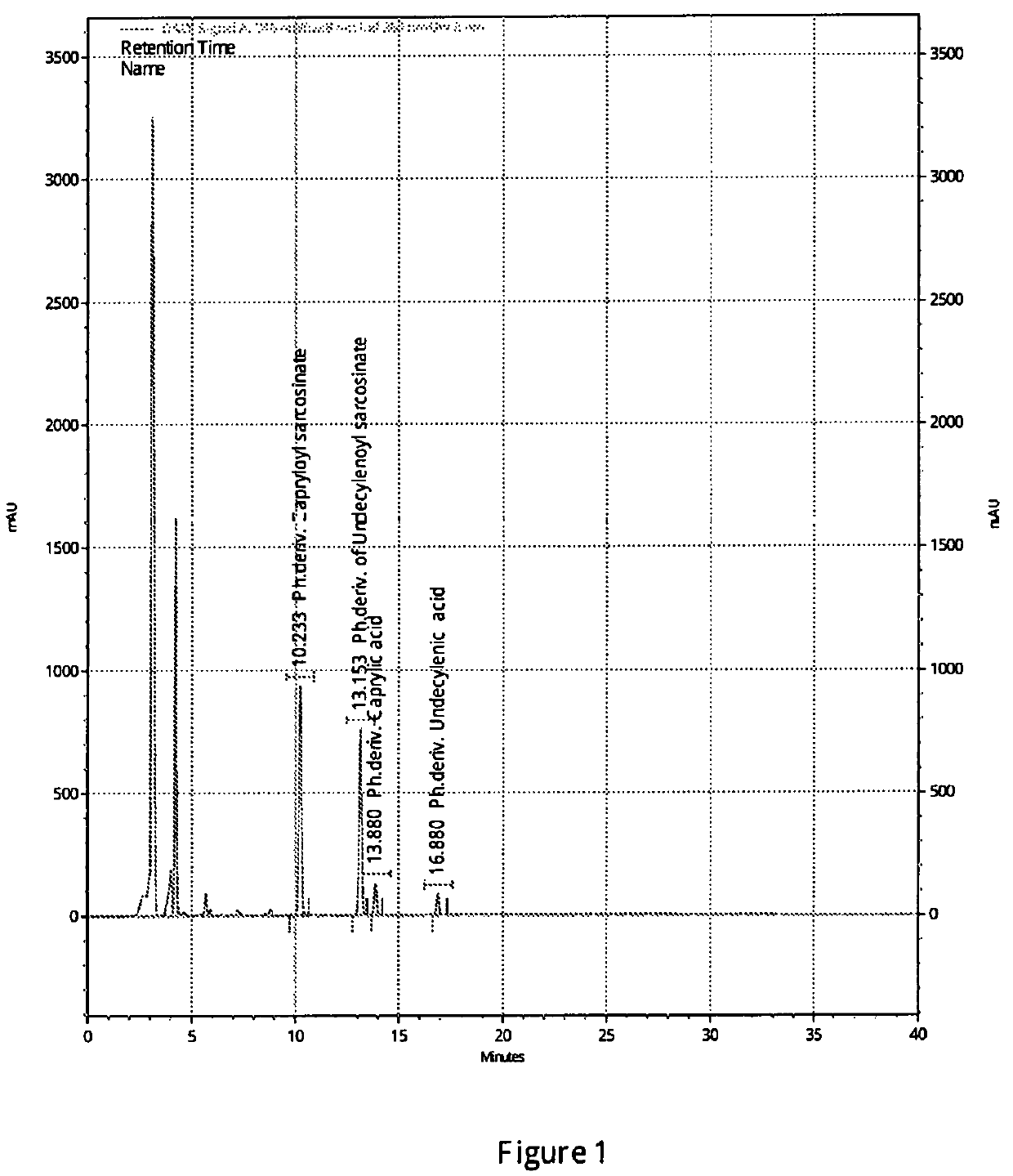N-acyl sarcosines as antimicrobials for preservation of home and personal care products
a technology of n-acyl sarcosine and antimicrobials, applied in the field of n-acyl sarcosines, can solve the problems of limited utility in the personal care industry, serious controversies, and antimicrobials considered very effective, and achieve the effects of less unit operation, minimal effluent generation, and low cos
- Summary
- Abstract
- Description
- Claims
- Application Information
AI Technical Summary
Benefits of technology
Problems solved by technology
Method used
Image
Examples
example 1
on of N-Undecylenoyl Sarcosine
[0053]To a stirred mixture of sarcosine (291 g of 40% aqueous solution, 1.05 gmol) in water (390 g) at 25 éC, undecylenoyl chloride (207 g, 1.0 gmol) and sodium hydroxide solution (83 g of 48% aqueous solution, 1 gmol) are added simultaneously while maintaining temperature between 20 éC to 30 éC and pH between 10.0 to 11.0. The addition takes about two hours. The reaction mass is stirred for additional two hours at 30 éC to 35 éC. The whole reaction mixture is then acidified with sulphuric acid and the aqueous phase containing the inorganic salt is separated from the organic phase. The organic phase is washed again with water to ensure that the organic phase is free from mineral acidity. The isolated organic phase contains N-undecylenoyl sarcosine as colorless liquid (240 g, 94% yield).
[0054]Analysis of N-Undecylenoyl Sarcosine:
[0055]Acid value=215, Moisture content=<1%
[0056]IR (neat, cm−1): 1603, 1732, 2854, 2925
[0057]1H-NMR (CDCl3): 1.21-1.29 (10H), 1...
example 2
on of N-Capryloyl Sarcosine
[0058]To a stirred mixture of sarcosine (291 g of 40% aqueous solution, 1.05 gmol) in water (320 g) at 25 éC, capryloyl chloride (166 g, 1.0 gmol) and sodium hydroxide solution (83 g of 48% aqueous solution, 1.0 gmol) are added simultaneously while maintaining temperature between 20 éC to 30 éC and pH between 10.0 to 11.0. The addition takes 4 to 5 hours depending on the efficiency of temperature control. The reaction mass is stirred for additional two hours. The whole reaction mixture is then acidified with sulphuric acid and the aqueous phase containing the inorganic salt is separated from the organic phase. The organic phase is washed again with water to ensure that the organic phase is free from mineral acidity. The isolated organic phase is made up of N-capryloyl sarcosine as colorless liquid (200 g, 93% yield).
[0059]Analysis of N-Capryloyl Sarcosine:
[0060]Acid value=255, Moisture content=<1%
[0061]IR (neat, cm): 1602, 1732, 2858, 2926
[0062]1H-NMR (CDC...
example 3
on of N-Capryloyl Sarcosine and N-Undecylenoyl Sarcosine in Weight Ratio of 1:1
[0063]To a stirred mixture of sarcosine (291 g of 40% aqueous solution, 1.05 gmol) in water (350 g) at 25 éC, undecylenoyl chloride (92 g, 0.45 gmol), capryloyl chloride (92 g, 0.55 gmol) and sodium hydroxide solution (83 g of 48% aqueous solution, 1 gmol) simultaneously while maintaining temperature between 20 éC to 30 éC and pH between 10.0 to 11.0. The addition takes about two hours. The reaction mass is stirred for additional two hours at 30 to 35 éC. The whole reaction mixture is then acidified with sulphuric acid and the aqueous phase containing the inorganic salt is separated from the organic phase. The organic phase is washed again with water to ensure that the organic phase is free from mineral acidity. The isolated organic phase is made up of N-undecylenoyl sarcosine and N-capryloyl sarcosine as colorless liquid (220 g, 94% yield).
[0064]Analysis of Blend of N-Undecylenoyl Sarcosine and N-Caprylo...
PUM
| Property | Measurement | Unit |
|---|---|---|
| antibiotic resistance | aaaaa | aaaaa |
| molecular structure | aaaaa | aaaaa |
| concentration | aaaaa | aaaaa |
Abstract
Description
Claims
Application Information
 Login to View More
Login to View More - R&D
- Intellectual Property
- Life Sciences
- Materials
- Tech Scout
- Unparalleled Data Quality
- Higher Quality Content
- 60% Fewer Hallucinations
Browse by: Latest US Patents, China's latest patents, Technical Efficacy Thesaurus, Application Domain, Technology Topic, Popular Technical Reports.
© 2025 PatSnap. All rights reserved.Legal|Privacy policy|Modern Slavery Act Transparency Statement|Sitemap|About US| Contact US: help@patsnap.com



